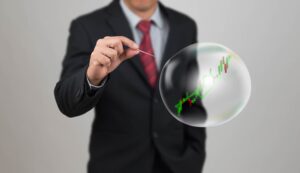“Everyone has a plan until they are punched in the face.” This famous Mike Tyson quote spells out the outlook for investors in the years ahead according to SocGen’s Albert Edwards, who warns that investors will not only be punched in the face, they will also get knocked to the floor and kicked repeatedly in the ribs. In the event it is best to roll up into a ball. This won?t prevent all injury, but it will help avoid the most damaging blows. The same applies to investors in the Ice Age.
On 4 June 2009 Edwards wrote:
“The big news this week is that the Coppock Indicator has turned upwards. This is one of the most reliable technical indicators suggesting we are in a new long-term bull market. The Conference Board leading indicator has also just turned up decisively. Is an investor who remains underweight equities, expecting decisive new lows brave, or plain stupid?”
The answer is that it was I who was incredibly stupid. I?m used to looking stupid most of time as within this secular bear market, cyclical rallies last many years longer than each short-lived cyclical bear phase. But each gut-wrenching downturn takes equity indices to new lower lows. That moment is imminent.
As SocGen’s Albert Edwards explains… We remain at the bearish extreme of the market.
It is not a pleasant place. It is cold, dark and damp. People either don?t speak to you or send you abusive e-mails. Members of your own family pretend not to know you. Actually, I made that last bit up. Although when I was going through my hippy phase in the second half of the 1970s (a decade too late), my mother did actually cross the street and walk past pretending she didn?t know me. Maybe that childhood experience of parental rejection made me the thick-skinned bear I am today?
As promised we have updated the Pring Turner chart…
It shows that the three previous US equity valuation bear markets (the top line being the real S&P) take a minimum of four recessions to play themselves out ? we have only suffered two since the peak of the bubble in 2000. The secular bear market only ends when cyclically-adjusted valuation measures reach rock bottom (such as the Shiller PE on the bottom line). Each successive recession (red part of real S&P ? top line) sees huge downturns, usually to new lower lows of both prices and valuations. That is why we reiterated our view early this year that in the coming recession the S&P will bottom at 550, a 75% decline from current levels.
The charts below are my favourite Ice Age charts, which I haven?t focused on for a long time.
The first shows the US equity earnings yield and the 10y bond yield back to 1950 and it demonstrates howsuccessful investing depends on knowing what secular phase the market is in. The long bull market of 1982-2000, when both bond yields and equity yields fell together, was a mirror image of the 1965-1982 period during which the Dow stagnated for 17 years in nominal terms. Between 1965 and 2000, equity and bond yields were positively correlated as bond yields and inflation drove equity yields. The current Ice Age secular phase since 2000 has seen that positive correlation between equity and bond yields break down ? it is a mirror image of the 1950-1965 period when equity prices rose substantially (yields fell) despite rising bond yields.
The above charts are a trip down memory lane for me, and at my age it?s nice to reconnect with familiar old friends. But the key to the Ice Age thesis is to sound CONDITION RED ALERT as each recession approaches, because the equity outcome then always proves much worse than anyone expects due to the additional phase of secular de-rating.
So are we approaching a US recession? In the aftermath of the latest, weaker than expected, nonfarm payroll data, economists are certainly more worried. The excellent folks at Advisor Perspectives highlight The Fed?s Labour Market Conditions Index as suggesting a recession is imminent (the cumulative peak is an average of 9 months ahead of the start of recession and we are now four months beyond a peak).
For investors who think copper still has some predictive power, its recent move is disturbing.
* * *
We are coming up to the 20th anniversary of SocGen’s Albert Edwards’ formulation of the Ice Age thesis.
Others have climbed aboard with similar ideas of Secular Stagnation. But the Ice Age was not only about economics and the drift towards deflation; it was also a description of how financial markets would react.
In the Ice Age, government bonds re-rate in absolute and relative terms against equities which de-rate in absolute terms. Equity investors endure a secular valuation bear market lasting many economic cycles, punctuated by cyclical rallies that beguile investors into thinking, like now, that the horrors of the Ice Age are over.






